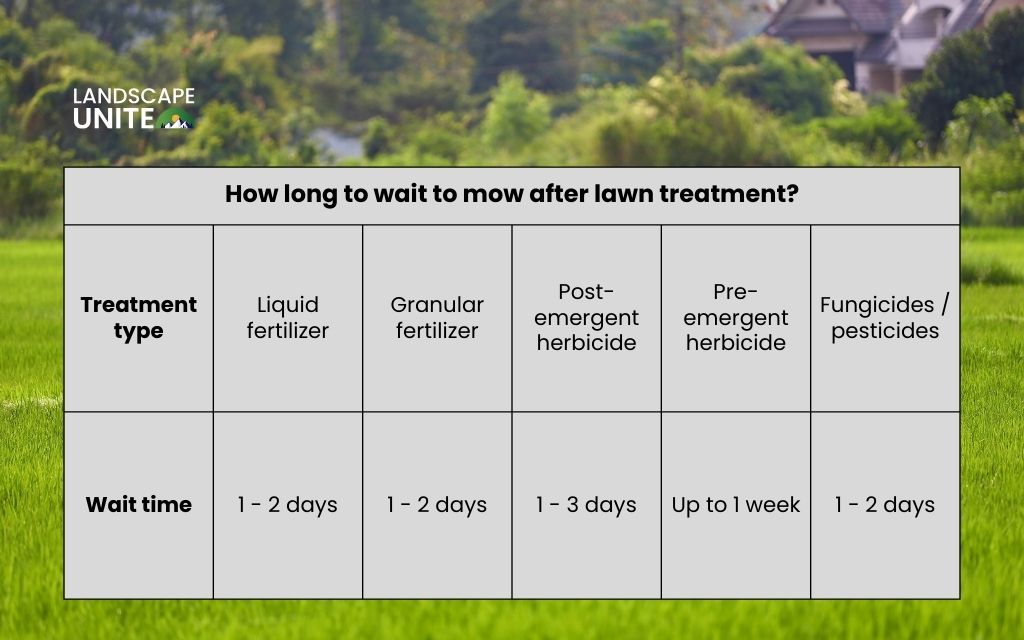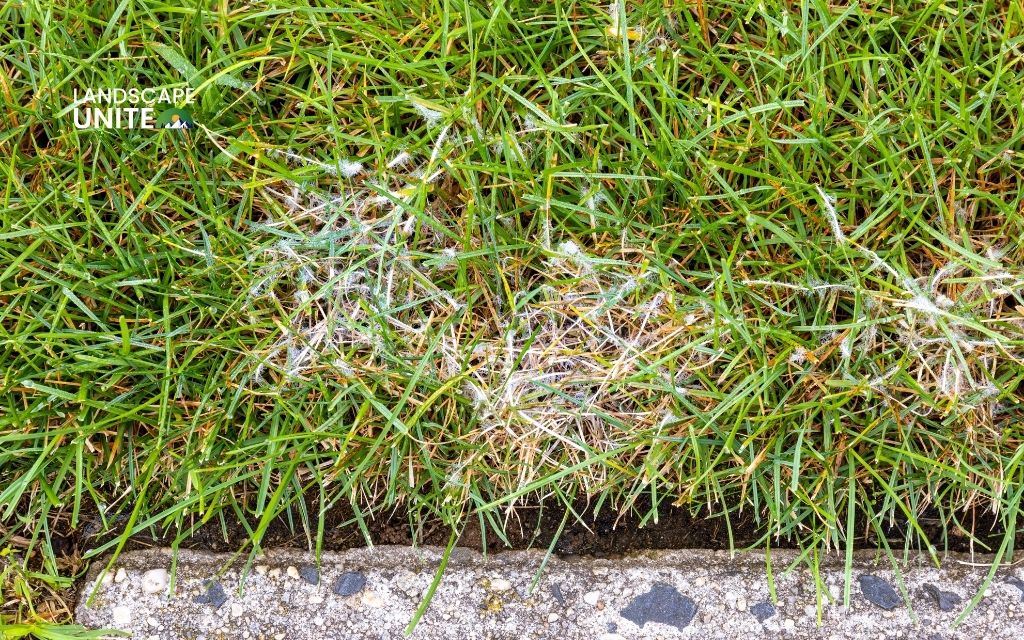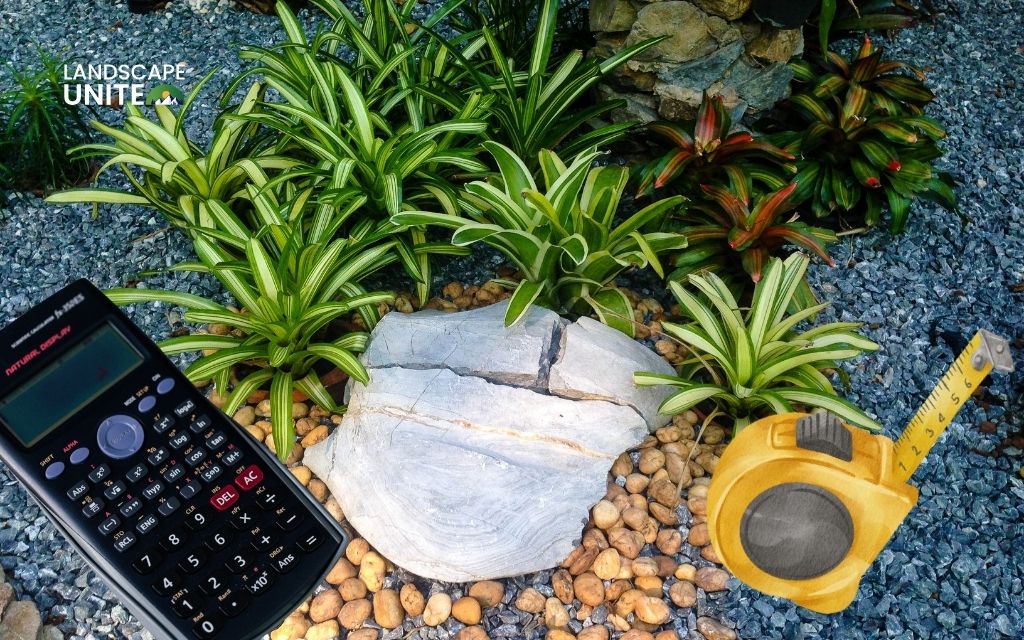How long to wait to mow after lawn treatment? Most lawn treatments require waiting 24-72 hours before mowing, depending on the type of product applied.
Granular and liquid fertilizers typically need 1-2 days, while herbicides may require 1-3 days, and pre-emergent treatments can need up to a week. This waiting period allows treatments to absorb properly and work effectively.
Proper timing between lawn treatments and mowing can make the difference between a healthy yard and wasted money on ineffective applications. Understanding these critical windows ensures maximum treatment effectiveness while protecting your investment in lawn care.
Keep reading below to discover the specific wait times for each treatment type and expert tips for optimal results.

How long to wait to mow after lawn treatment?
The waiting period between lawn treatment application and mowing varies significantly based on the type of treatment applied. Each product category has unique absorption rates and effectiveness requirements that determine safe mowing intervals.
Fertilizer treatment
Granular fertilizers
Wait 24 – 48 hours before mowing to allow granules to dissolve and absorb effectively. These slow-release nutrients need time to break down and penetrate the soil surface.
Mowing too early can scatter undissolved granules, creating uneven distribution and reducing overall effectiveness. Weather conditions play a crucial role – humid conditions speed dissolution while dry weather may require the full 48-hour window.
Liquid fertilizers
Typically safe to mow in 1 – 2 days, depending on product instructions and absorption rates. Liquid formulations absorb more rapidly through grass blades and soil contact, but complete uptake still requires 12 – 48 hours.
Fast-acting liquid nitrogen fertilizers may show visible green-up within hours, indicating active absorption, while slow-release liquid blends need the full recommended waiting period.
Herbicides / Weed control treatment
Post-emergent herbicides
Wait 24–72 hours after application to ensure absorption into weed systems.
These selective or non-selective treatments must translocate through weed foliage to reach root systems for complete kill. Mowing too soon removes treated leaf surfaces before herbicide translocation occurs, allowing weeds to recover and requiring costly reapplication.
Pre-emergent herbicides
These need longer – allow up to a week or more before mowing to maintain soil barrier effectiveness.
Pre-emergent treatments create a chemical barrier in the top soil layer that prevents weed seeds from germinating. Early mowing can disrupt this barrier through soil disturbance and clipping removal, compromising season-long weed prevention.
Fungicides & pesticides treatment
Wait at least 24 – 48 hours post-application to allow active ingredients to settle and act effectively. Fungicide treatments require time to establish protective coating on grass surfaces and penetrate plant tissues for systemic protection.
Insecticide applications need similar settling time to create effective residual control zones.
Weather conditions significantly impact these timelines – high temperatures and humidity accelerate absorption while cool, dry conditions extend required waiting periods.

Additional wait-time considerations
Grass recovery
Treatments can stress turf through chemical contact and application processes. Delaying mowing provides recovery time for grass plants to metabolize treatments and resume normal growth patterns.
Stressed grass cut too early shows increased susceptibility to disease, drought damage, and uneven growth patterns that affect overall lawn appearance.
Rain and watering can wash away treatments
Light irrigation 24 hours after granular applications helps dissolution and soil contact, but heavy rainfall within 6 hours can wash away surface treatments before absorption occurs.
Monitor weather forecasts and extend waiting periods when precipitation threatens treatment effectiveness.
Always refer to the product instructions
Manufacturer testing determines optimal absorption rates, safety intervals, and effectiveness windows specific to each formulation.
Environmental conditions, grass species, and application rates all influence these recommendations, making label compliance essential for successful results.
Why timing your mow matters
Mowing too soon can scatter or remove treatments like herbicides or granular fertilizers, reducing effectiveness dramatically. Lawn mower blades create air currents that disperse granular materials before soil incorporation occurs.
Similarly, grass clippings removed during premature mowing may contain significant amounts of recently applied liquid treatments, reducing available active ingredients for target absorption.
Improper timing can stress grass and lead to patchy results or damage throughout the growing season. Chemical treatments temporarily alter grass metabolism and growth patterns.
Adding mowing stress during this vulnerable period can cause browning, thinning, or death in treated areas. Recovery from combined treatment and mowing stress often requires weeks of careful management and may necessitate overseeding or renovation in severely affected areas.
Best practices around mowing and treatments
Mow before treating
Particularly effective before fertilizing to ensure better contact and even coverage across all grass surfaces.
Fresh-cut grass provides optimal surface area for liquid absorption while removing excess foliage that might intercept granular materials before soil contact.
This sequence also eliminates the need to bag clippings that might contain treatment residues.
Wait for grass to dry
Wet turf can spread disease and reduce cut cleanliness while interfering with treatment effectiveness. Mowing wet grass creates clumping, uneven cutting heights, and potential equipment damage.
Additionally, moisture on grass blades can dilute liquid treatments and prevent proper granular dissolution rates.
Avoid cutting more than 1/3 of grass height
This fundamental rule becomes even more critical after treatments when grass may be experiencing chemical stress. Excessive cutting removes energy-producing leaf surface during a period when grass needs maximum photosynthetic capacity for treatment recovery and continued healthy growth.

Regional & seasonal considerations
Warm climates
Faster absorption rates mean liquid fertilizers may require only the minimum wait times, but always verify product-specific requirements.
High temperatures and humidity in southern regions accelerate chemical uptake, while extended growing seasons provide more treatment opportunities.
However, heat stress can also increase treatment sensitivity, making proper timing more critical for avoiding damage.
Cool seasons or slow-growing grass
Drying and absorption take significantly longer during cooler periods – consider extending wait times toward the maximum recommended ranges.
Northern grasses entering dormancy periods show reduced metabolic activity, extending treatment absorption windows. Spring applications during cool weather may require 48-72 hours even for typically fast-acting treatments.
Rainy or drought conditions
Delay mowing if treatments may wash away or create additional stress on already compromised turf. Drought-stressed grass shows increased sensitivity to both chemical treatments and mowing stress.
Conversely, saturated soils from excessive rainfall can wash away treatments before absorption while creating anaerobic conditions that stress grass roots.
Conclusion
Waiting the correct amount of time – even a small delay – helps ensure lawn treatments fully work and protects your yard’s long-term health and appearance.
Match your mowing schedule to the treatment type and follow label guidance for optimal results during every season. Proper timing maximizes your investment in lawn care products while preventing costly damage that requires expensive renovation.
Learn more about comprehensive lawn care strategies and seasonal maintenance in our extensive gardening library, where expert advice helps you achieve the healthy, beautiful lawn you desire.
Frequently asked questions (FAQs)
Can I mow 24 hours after liquid fertilizer?
Generally yes. Liquid fertilizers absorb faster and may require only 12–48 hours before mowing safely. However, always check the specific product label for manufacturer recommendations, as formulation differences can affect absorption rates significantly.
What if it rains right after treatment?
Rain can wash away treatments before proper absorption occurs. Wait longer before mowing, as rainfall can reduce effectiveness substantially and may require reapplication depending on timing and intensity.
Is it okay to mow before fertilizing?
In many cases, yes. Cutting before applying treatments can improve fertilizer contact and absorption by removing excess foliage and creating better soil access for granular products.
What happens if you mow right after fertilizing?
Mowing too soon scatters granules unevenly, removes liquid treatments, and stresses grass, resulting in patchy results and reduced effectiveness.
Is October too late to spray weeds?
Depends on location. Northern regions: less effective as weeds prepare for dormancy. Southern regions: still effective for winter weeds beginning growth.


